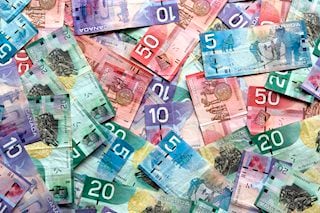USD/CAD holds comfortably above 1.3900 mark amid notable USD strength
|
- USD/CAD gains positive traction for the second successive day on Monday amid a bullish USD.
- Subdued Oil prices undermine the Loonie and lend support amid bets for a jumbo BoC rate cut.
- Traders await the US consumer inflation and Fed Chair Jerome Powell’s speech later this week.
The USD/CAD pair attracts buyers for the second successive day on Monday and sticks to its modest intraday gains, around the 1.3925 region through the first half of the European session. Spot prices draw support from a combination of factors and remain within the striking distance of the highest level since October 2022 retested last week.
Crude Oil prices struggle to gain any meaningful traction amid the disappointment over China's fiscal stimulus and softer-than-expected Chinese inflation figures, which tempered hopes for a fuel demand recovery in the world's top importer. Meanwhile, Friday's mixed Canadian employment figures do little to dent market expectations about a more aggressive easing by the Bank of Canada (BoC). This, in turn, is seen undermining the commodity-linked Loonie, which, along with a bullish US Dollar (USD) buying, pushes the USD/CAD pair higher at the start of a new week.
The USD Index (DXY), which tracks the Greenback against a basket of currencies, climbs back closer to a four-month top touched last week amid the optimism over US President-elect Donald Trump's expansionary policies. Furthermore, Trump's pledge to impose a universal 10% tariff on imports from all countries is expected to boost inflation and restrict the Federal Reserve (Fed) to ease its monetary policy more aggressively. This remains supportive of elevated US Treasury bond yields, which, along with the cautious market mood, continues to benefit the safe-haven buck.
The USD bulls, however, could pause for a breather ahead of the release of the US consumer inflation figures and speeches by a slew of influential FOMC members, including Fed Chair Jerome Powell later this week. Nevertheless, the fundamental backdrop suggests that the path of least resistance for the Greenback and the USD/CAD pair remains to the upside. Hence, any corrective pullback might still be seen as a buying opportunity and remain limited in the wake of a partial holiday in the US and Canada.
Canadian Dollar FAQs
The key factors driving the Canadian Dollar (CAD) are the level of interest rates set by the Bank of Canada (BoC), the price of Oil, Canada’s largest export, the health of its economy, inflation and the Trade Balance, which is the difference between the value of Canada’s exports versus its imports. Other factors include market sentiment – whether investors are taking on more risky assets (risk-on) or seeking safe-havens (risk-off) – with risk-on being CAD-positive. As its largest trading partner, the health of the US economy is also a key factor influencing the Canadian Dollar.
The Bank of Canada (BoC) has a significant influence on the Canadian Dollar by setting the level of interest rates that banks can lend to one another. This influences the level of interest rates for everyone. The main goal of the BoC is to maintain inflation at 1-3% by adjusting interest rates up or down. Relatively higher interest rates tend to be positive for the CAD. The Bank of Canada can also use quantitative easing and tightening to influence credit conditions, with the former CAD-negative and the latter CAD-positive.
The price of Oil is a key factor impacting the value of the Canadian Dollar. Petroleum is Canada’s biggest export, so Oil price tends to have an immediate impact on the CAD value. Generally, if Oil price rises CAD also goes up, as aggregate demand for the currency increases. The opposite is the case if the price of Oil falls. Higher Oil prices also tend to result in a greater likelihood of a positive Trade Balance, which is also supportive of the CAD.
While inflation had always traditionally been thought of as a negative factor for a currency since it lowers the value of money, the opposite has actually been the case in modern times with the relaxation of cross-border capital controls. Higher inflation tends to lead central banks to put up interest rates which attracts more capital inflows from global investors seeking a lucrative place to keep their money. This increases demand for the local currency, which in Canada’s case is the Canadian Dollar.
Macroeconomic data releases gauge the health of the economy and can have an impact on the Canadian Dollar. Indicators such as GDP, Manufacturing and Services PMIs, employment, and consumer sentiment surveys can all influence the direction of the CAD. A strong economy is good for the Canadian Dollar. Not only does it attract more foreign investment but it may encourage the Bank of Canada to put up interest rates, leading to a stronger currency. If economic data is weak, however, the CAD is likely to fall.
Information on these pages contains forward-looking statements that involve risks and uncertainties. Markets and instruments profiled on this page are for informational purposes only and should not in any way come across as a recommendation to buy or sell in these assets. You should do your own thorough research before making any investment decisions. FXStreet does not in any way guarantee that this information is free from mistakes, errors, or material misstatements. It also does not guarantee that this information is of a timely nature. Investing in Open Markets involves a great deal of risk, including the loss of all or a portion of your investment, as well as emotional distress. All risks, losses and costs associated with investing, including total loss of principal, are your responsibility. The views and opinions expressed in this article are those of the authors and do not necessarily reflect the official policy or position of FXStreet nor its advertisers.